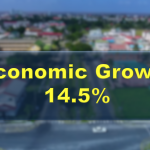
The International Monetary Fund (IMF) has noted that Guyana’s economic transformation is advancing strongly and broadening in scale, but is also encouraging greater protection against the “Dutch Disease”.
“Dutch disease” is an economic term used for the negative consequences that can arise from a spike in the value of a nation’s currency, that is primarily associated with the new discovery or exploitation of a valuable natural resource and the unexpected repercussions that such a discovery can have on the overall economy of a nation.
In a statement by the Executive Director of the IMF, it was noted that in Guyana’s rapidly expanding oil production, strong non-oil output, and large-scale public infrastructure investment supported the highest real GDP growth rate in the world, averaging 47 percent per year since 2022.
According to the IMF, Real oil GDP increased by nearly 58 percent in 2024, while real non-oil GDP expanded over 13 percent, reflecting a solid performance across sectors.
The report, however, noted that Inflation increased to 2.9 percent by the end of last year, from 2 percent at end 2023, driven largely by higher food prices.
Further, the IMF noted that the country’s overall fiscal deficit widened from 5.1 percent of GDP (11.7 percent of non-oil GDP) in 2022 to 7.3 percent of GDP (21 percent of non-oil GDP) in 2024 reflecting a large increase in capital expenditure.
The IMF noted that future oil discoveries will serve as a cushion for any short-term economic challenge the country may face,
“On the upside, further oil discoveries and productivity-enhancing investment would improve Guyana’s long-term economic prospects, while expanding construction activity may support higher short-term non-oil GDP growth. On the downside, overheating pressures, if not contained, would lead to higher inflation and real exchange rate appreciation beyond the level consistent with a balanced expansion of the economy, negatively impacting medium-term growth,” the IMF said in its report.
According to the report, Guyana’s economic outlook remains highly favourable and that the economy is expected to grow on average 14 percent per year over the next five years, driven by robust oil production and strong non-oil GDP growth.
While the oil sector is playing a crucial role in expanding the country’s economy, more still needs to be done to avoid the “Dutch disease”.
Guyana’s initial economic conditions—limited foodrelated manufacturing sector, relatively flexible labor markets, operating SWF, and still considerable slack in the economy—can help mitigate the immediate symptoms of Dutch disease and manage them in the medium term. Recent high growth rates in the construction and service sectors would require timely and continuous monitoring to foresee and proactively address inflationary pressures, while a medium-term strategy to provide diversified and broad-based economic growth, including by boosting human capital and rapidly enhancing the country’s institutional framework would be needed to appropriately manage any emerging symptoms of Dutch disease.
Going forward, the IMF said the Government should continue strengthening its “Dutch disease” mitigation policies towards developing and implementing medium-term fiscal framework to smooth spending and supporting the diversification of the economy, including export diversification strategies and the expansion of the manufacturing sector through structural reforms and investment programs while enhancing productivity in non-oil tradable sectors by improving business environment, including through investing in resilient infrastructure, ensuring reliable and affordable energy supply, investing in human capital, and strengthening governance.













You must be logged in to post a comment Login